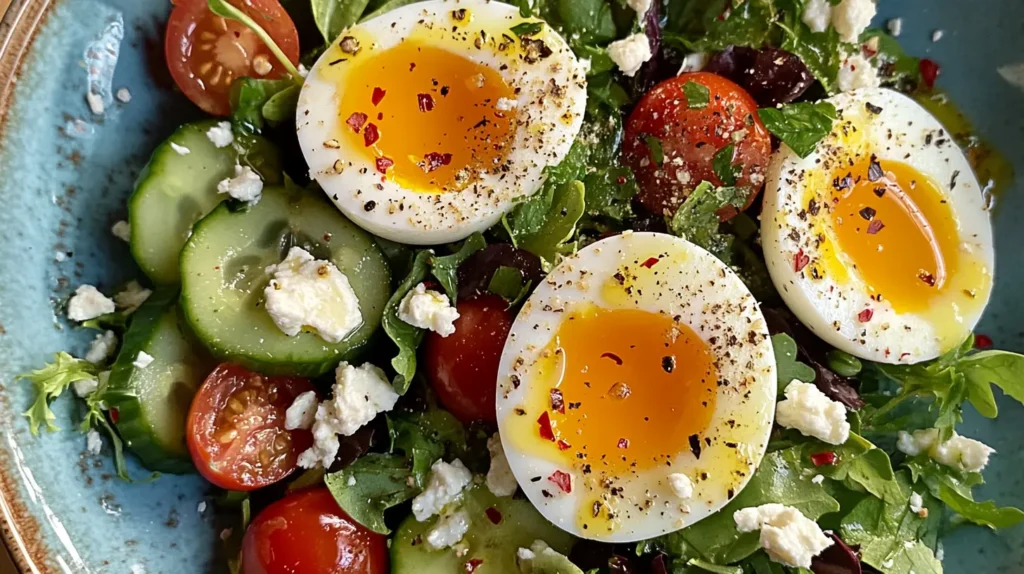Perfectly cooked eggs are a culinary delight, but few preparations can rival the creamy, rich texture of jammy eggs. Whether you’re sprucing up your breakfast, crafting a hearty ramen bowl, or simply craving a protein-packed snack, jammy eggs are a versatile and easy-to-make treat. In this guide, we’ll explore everything you need to know—from what makes jammy eggs so special to the techniques that guarantee perfect results every time. Along the way, you’ll discover tips, serving ideas, and even nutritional perks that make jammy eggs a go-to recipe.
What Are Jammy Eggs?
Introduction to Jammy Eggs
Jammy eggs are a culinary marvel, striking the perfect balance between soft-boiled and hard-boiled eggs. Their standout feature? A silky, golden yolk with a gel-like consistency that oozes with just the right amount of richness. The white is firm yet tender, making them ideal for slicing, dipping, or eating whole.
The term “jammy” refers to the yolk’s thick and slightly runny texture—reminiscent of jam. Unlike fully cooked eggs with crumbly yolks, jammy eggs deliver a luscious, melt-in-your-mouth experience that elevates any dish they’re paired with.
Why They’re a Favorite
What makes jammy eggs so popular? For starters, they’re incredibly versatile. You can serve them over toast, toss them in a salad, or use them as a topping for noodles or rice bowls. Their unique texture and rich flavor make them a fan favorite, whether you’re hosting brunch or whipping up a quick weekday meal. Plus, they’re easy to prepare with minimal ingredients and effort.
Origins of Jammy Eggs
While soft-boiled eggs have been a breakfast staple for centuries, the modern obsession with jammy eggs likely stems from their use in trendy Asian-inspired dishes like ramen. Over time, they’ve gained traction as a versatile ingredient in Western cuisines, celebrated for their simplicity and satisfying texture.
The Perfect Jammy Egg Recipe
Ingredients Needed
Making jammy eggs doesn’t require fancy tools or obscure ingredients—just a few kitcMaking jammy eggs doesn’t require fancy tools or obscure ingredients—just a few kitchen staples, and you’re good to go. In fact, the simplicity of this jammy eggs recipe is part of what makes it so appealing. Here’s exactly what you’ll need to get started:
- Fresh eggs (as many as you want to prepare)
- Water for boiling
- Ice water for cooling
- Salt and pepper (optional for serving)
And that’s all! Simple, right? Moreover, the magic of jammy eggs lies not in complicated ingredients, but in mastering the method. So, once you’ve gathered these basics, you’re ready to make perfectly creamy, delicious eggs.
Step-by-Step Instructions
- Boil the Water: Start by filling a medium-sized pot with water, enough to submerge your eggs fully. Bring it to a rolling boil over high heat.
- Lower the Eggs: Gently place your eggs into the boiling water using a spoon to avoid cracking the shells.
- Set the Timer: For that perfect jammy texture, cook the eggs for exactly 6½ to 7 minutes. Timing is crucial!
- Prepare an Ice Bath: While the eggs cook, fill a bowl with cold water and plenty of ice. This will halt the cooking process instantly.
- Transfer the Eggs: Once the timer goes off, scoop the eggs out and drop them into the ice bath. Let them sit for about 5 minutes to cool completely.
- Peel with Care: Tap the eggs gently on a hard surface to crack the shell, then peel them under running water to make the process smoother.
Congratulations, you’ve just nailed the ultimate jammy eggs recipe!
Tips for Consistency
- Use room-temperature eggs for more even cooking.
- If you’re boiling multiple eggs, ensure they’re in a single layer to cook evenly.
- Want a slightly firmer yolk? Add 30 seconds to your cooking time.
Common Mistakes to Avoid
- Overcooking: Even an extra minute can ruin the jammy consistency.
- Skipping the Ice Bath: This step prevents carryover cooking, which can make the yolk too firm.
- Using Old Eggs: Fresher eggs peel easier and cook more predictably.
Cooking Times and Techniques
Timing is Key
When it comes to a successful jammy eggs recipe, timing is everything. The sweet spot for jammy eggs lies between 6½ to 7 minutes of boiling. Less than this, and you risk having an overly runny yolk. Any longer, and you’ll inch toward hard-boiled territory.
Temperature Considerations
The water temperature also plays a big role. Always start with boiling water before adding the eggs. Adding eggs to cold water leads to uneven cooking, with whites that can turn rubbery. To maintain a steady boil, reduce the heat slightly after adding the eggs.
Another pro tip: If you’re cooking at high altitude, you may need to increase your cooking time by 30 seconds or so, as water boils at a lower temperature in these conditions.
Peeling Hacks
Peeling eggs can be tricky, but it doesn’t have to be. Here are a few tried-and-true tricks:
- Use eggs that are at least a week old; the shells will separate more easily.
- Gently roll the egg on a flat surface after it cools to loosen the shell.
- Peel under cold running water for a smoother process.
Serving Suggestions and Pairings
Jammy eggs are the ultimate breakfast companion! Their velvety yolks pair beautifully with buttery toast, avocado slices, or even a hearty English muffin. Want to elevate your breakfast game? Try adding jammy eggs to a breakfast bowl with quinoa, roasted vegetables, and a drizzle of olive oil.

Incorporating Jammy Eggs into Lunch or Dinner
Are you looking for ways to incorporate jammy eggs into your lunch or dinner? If so, you’ll be happy to know they’re a perfect addition to a wide range of dishes, from salads to grain bowls and even noodle recipes. For instance, you can toss a halved egg into a spinach salad with feta and walnuts for added creaminess and protein. Or, place a jammy egg atop a rice bowl with teriyaki chicken for an instant upgrade that’s both satisfying and flavorful.
One standout pairing, however, is using jammy eggs as a topping for ramen. Not only does the creamy yolk blend seamlessly with the broth, but it also creates an irresistibly rich and comforting flavor. Alternatively, you could slice the eggs and arrange them over a tomato and mozzarella platter for a quick, yet delicious, Mediterranean twist.
Moreover, jammy eggs can easily be adapted to various cuisines, making them a versatile ingredient for creative dishes. For more recipe inspiration, check out this article on baked egg casseroles, which offers yet another innovative way to enjoy eggs at any meal. Ultimately, with jammy eggs, the possibilities are endless!
Jammy Eggs in Global Cuisine
Jammy eggs have also earned a spot in global dishes. In Japanese cuisine, they’re known as “ajitsuke tamago,” a staple in ramen bowls. Similarly, they’re a favorite topping in Korean bibimbap, adding creaminess to the spicy, savory flavors. In Mediterranean cuisine, they’re often paired with hummus and pita for a quick snack.
Health Benefits of Jammy Eggs
Nutritional Profile
Jammy eggs aren’t just a treat for your taste buds—they’re packed with nutrients that support your overall health. Each egg is a nutritional powerhouse, offering around 6 grams of high-quality protein and a wealth of essential vitamins and minerals. From vitamin B12, which supports brain function, to selenium, a mineral with antioxidant properties, jammy eggs deliver an impressive array of health benefits.
Additionally, the yolk in a jammy eggs recipe retains many of its natural nutrients thanks to the shorter cooking time. This includes fat-soluble vitamins like A, D, E, and K, which are essential for everything from maintaining healthy vision to supporting bone health.
Protein Powerhouse
Eggs are well-known as one of the most affordable sources of high-quality protein. The protein in eggs is considered complete, meaning it contains all nine essential amino acids your body needs for growth, repair, and maintenance. Including jammy eggs in your meals can be especially beneficial for those on a fitness journey or anyone looking to stay satiated for longer periods.
Unlike hard-boiled eggs, jammy eggs with their soft, gel-like yolk may feel richer and more indulgent, making them a satisfying addition to your diet without overloading on calories.
Low-Calorie, High-Satisfaction Food
Jammy eggs are a prime example of how healthy eating doesn’t have to feel restrictive. At less than 80 calories per egg, they provide a guilt-free way to enjoy something creamy and delicious. The balance of protein and healthy fats in the yolk means jammy eggs can keep you feeling full for hours, making them a fantastic choice for weight management.
For those looking to reduce their calorie intake while maintaining nutrition, jammy eggs work well in low-calorie meals. Try them with a salad of leafy greens, cucumbers, and a drizzle of lemon vinaigrette for a refreshing, satisfying dish.
Great for Specialized Diets
Jammy eggs are a versatile option for various diets. They’re naturally gluten-free, making them suitable for those with gluten sensitivities or celiac disease. Thanks to their low carbohydrate content, they’re also a perfect fit for keto and low-carb diets.
Even vegetarians who consume eggs can benefit from adding jammy eggs to their meals. They offer a quick, portable source of protein that complements vegetarian staples like grains, legumes, and vegetables.
Better Nutrient Absorption
Did you know that pairing jammy eggs with other foods can enhance nutrient absorption? The fats in egg yolks help your body absorb fat-soluble vitamins found in vegetables. For example, adding jammy eggs to a spinach or kale salad can boost your uptake of vitamin K and carotenoids, which support eye health and reduce inflammation.
Rich Flavor, No Added Fat
Another great benefit of jammy eggs is their ability to deliver rich, creamy flavor without needing butter, cream, or added oils. This makes them an excellent choice for anyone aiming to cut back on saturated fats while still enjoying indulgent textures in their meals.
Jammy eggs truly are a nutritional and culinary win, offering so much more than just great taste. With their impressive health benefits and versatility, it’s no wonder the jammy eggs recipe has become a favorite in kitchens worldwide.
Variations and Twists on Jammy Eggs
Seasoning Ideas
One of the best things about a jammy eggs recipe is its versatility. For instance, with just a sprinkle of seasoning, you can easily customize the eggs to complement any dish or flavor profile. To start with, for a simple upgrade, add a dash of flaky sea salt and freshly cracked black pepper. If you’re feeling adventurous, try smoked paprika, chili powder, or even a drizzle of hot sauce to add a fiery kick.
In addition, for a more global twist, you can experiment with furikake seasoning—a Japanese blend of sesame seeds, dried seaweed, and spices—that adds a unique, savory touch. Alternatively, za’atar, a Middle Eastern spice mix, brings a tangy, earthy flavor that pairs wonderfully with jammy eggs. Finally, a few drops of soy sauce or sesame oil can create a rich, umami-packed experience. By using these simple yet diverse seasonings, you can transform your jammy eggs into a flavor-packed component of any meal.
International Twists
If you’re craving variety, there are plenty of creative takes on the classic jammy eggs recipe inspired by international cuisines. For example, in Thai-inspired dishes, you can serve jammy eggs with a side of spicy chili paste and sticky rice. Meanwhile, for a Mediterranean vibe, try topping them with a drizzle of olive oil, a sprinkle of oregano, and a crumble of feta cheese for added texture and tanginess.
Furthermore, don’t be afraid to get experimental. In fact, these versatile eggs can effortlessly fit into countless dishes, whether as a centerpiece or a flavorful addition. Ultimately, by drawing inspiration from global cuisines, you’ll discover how jammy eggs can enhance any meal, adding both flavor and richness to whatever you’re serving.
FAQs About Jammy Eggs
How Do I Store Jammy Eggs?
Once you’ve mastered your jammy eggs recipe, you might wonder how to store any leftovers. Place peeled or unpeeled eggs in an airtight container in the refrigerator. They’ll stay fresh for up to three days.
Can I Reheat Jammy Eggs?
Reheating these delicate eggs is tricky, as excessive heat can ruin their soft yolk. Instead, let them sit at room temperature for a few minutes or submerge them briefly in warm water.
What’s the Difference Between Jammy Eggs and Soft-Boiled Eggs?
The main difference lies in the yolk’s texture. While soft-boiled eggs have a runny yolk, jammy eggs feature a slightly thicker, gel-like consistency—perfect for a richer taste experience.

